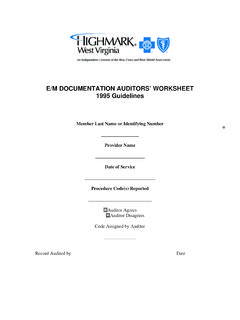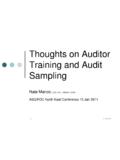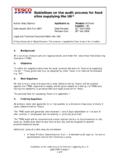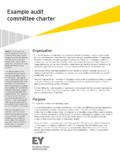Transcription of National Health Care Billing Audit Guidelines as …
1 Final National Health care Billing Audit Guidelines as amended by The American Association of Medical Audit Specialists (AAMAS). May 1, 2009. Preface Billing audits serve as a check and balance to help ensure that the Billing and claims processing procedures match services provided with charges billed. These Guidelines establish a basic framework for Billing Audit procedures and offer a guide on how all parties should conduct themselves during an Audit . They also offer common approaches and requirements for the substantiation of healthcare charges related to any Audit . The spirit or intent of these Guidelines should be adhered to by all parties to a Billing Audit . These Guidelines are not meant to circumvent special requirements or restrictions established either by law or by contract between the parties involved in such audits. While it is recognized that aspects of these Guidelines may apply to many of the different types of audits that are conducted in the healthcare setting (see Addendum A) this document is designed to address the conduct of Hospital Bill Audits.
2 I. Guidelines These Guidelines are for audits that relate to the documentation or support of charges included in or omitted from a bill. These Guidelines do not address questions concerning: the level or scope of care , medical necessity, or the pricing structure of items or services delivered by providers. Providers and payers should have qualified personnel and mechanisms in place to deal with these issues. 2. Definitions Audit log: An historical record kept by a payer or provider that records the Audit experience related to a particular party. Bill: Any document that represents a provider's request for payment. (Also referred to as an invoice or claim.). Billing Audit : A process to determine whether data in a provider's Health record, and/or appropriate and referenced medical policies, documents or supports services listed on a provider's bill. Providers conduct such audits either through an internal process or by hiring an external Audit firm. (These audits can be conducted on a retrospective or concurrent basis and commonly are referred to as revenue recovery audits.)
3 Also, third party payers conduct Billing audits through their employees or their agents. (Also known as chart Audit or charge review.). Concurrent Audit : a Billing Audit conducted before the issuance of an interim or final bill. Retrospective Audit : a Billing Audit conducted after the issuance of a final bill. Health record: A compilation of data supporting and describing an individual's Health care encounter including data on diagnoses, treatment, and outcomes. (Formerly known as medical record or clinical record.). Payers: In Health care , generally refers to entities including the patient that finance or reimburse the cost of Health services. In most cases, this term refers to insurance carriers, other third-party payers, or Health plan sponsors (employers or unions). Providers: Any healthcare provider ( , hospital, skilled nursing facility, home Health agency, outpatient physical therapy, comprehensive outpatient rehabilitation facility, end-stage renal disease facility, hospice, physician, non-physician provider, laboratory, supplier, etc.)
4 Providing medical services. Unbilled charges: Services that are documented but were never billed originally Undercharges: the volume of services indicated on a bill is less than the volume identified in a provider's Health record documentation Unsupported or undocumented charges: the volume of services indicated on a bill exceeds the total volume identified in a provider's Health record documentation. (Also known as over- charges.). 3. II. Confidentiality and Authorizations All parties to a Billing Audit must comply with the federal HIPAA Privacy Rules as regards to confidentiality of patient information. State and/or contractual agreements will only supersede the HIPAA regulations if their confidentiality requirements are more stringent or limiting in disclosure than the HIPAA. All payer and provider organizations (covered entities) and all Audit organizations, their employees, and sub-contractors (business associates) conducting or involved with Billing audits must maintain policies and procedures ensuring the confidentiality of patient protected Health information (PHI) in their possession and the proper disposal of this information.
5 A separate patient authorization is not required for the performance of payment activities including review of the Health care services for justification of charges. The HIPAA Privacy Rule (45 CFR ) permits a covered entity to use and disclose protected Health information, with certain limits and protections, for treatment, payment and Health care operation activities . Occasionally there are circumstances that require a separate patient authorization. Some examples of these circumstances are mental Health illness, HIV, genetic testing, and substance abuse. In these circumstances, the patient authorization shall include at least the following information: Patient's full name, address, and date of birth Purpose for releasing/obtaining the information Date the consent was signed Signature of patient or legal representative It is the responsibility of the Audit coordinator or Health Information Management (HIM). representative to inform the requestor in a timely manner if a separate authorization will be required.
6 III. Qualifications of Auditors and Audit Coordinators All persons performing Billing audits as well as persons functioning as provider Audit coordinators should have appropriate knowledge, experience, and/or expertise in a number of areas of Health care including, but not limited to the following areas: format and content of the Health record as well as other forms of medical/clinical documentation generally accepted auditing standards and practices as they may apply to Billing audits coding, including applicable ICD-CM, CPT, HCPCS, and medical terminology applicable Billing claims forms, including the UB-04, and the CMS 1500; plus charging and Billing procedures all state and federal regulations concerning the use, disclosure, and confidentiality of all 4. patient records, including the HIPAA. specific critical care units, specialty areas, and/or ancillary units involved in a particular Audit Providers or payers who encounter Audit personnel who do not meet these qualifications should immediately contact the auditor's firm or sponsoring party.
7 Audit personnel should be able to work with a variety of Health care personnel and patients. They should always conduct themselves in an acceptable, professional manner and adhere to ethical standards, confidentiality requirements, and objectivity. They should completely document their findings and problems. All unsupported or unbilled charges identified in the course of an Audit must be documented in the Audit report by the auditor. Compensation of Audit personnel should be structured so that it does not create incentives which could appear inappropriate or produce questionable Audit findings. Providers or payers who encounter an individual who appears to be involved in a conflict of interest should contact the appropriate management of the sponsoring organization. IV. Notification of Audit Payers and providers should make every effort to resolve Billing inquiries directly. To support this process, the name and contact telephone number (and/or facsimile number, email address) of each payer or provider representative should be exchanged no later than the time of Billing for a provider and the point of first inquiry by a payer.
8 If a satisfactory resolution of the questions surrounding the bill is not achieved by payer and provider representatives, then a full Audit process may be initiated by the payer. Generally, Billing audits require documentation from or review of a patient's Health record and other similar medical/clinical documentation. Health records exist primarily to ensure continuity of care for a patient; therefore, the use of a patient's Health record for an Audit must be secondary to its use in patient care . To alleviate the potential conflict with clinical uses of the Health record and to reduce the cost of conducting a necessary Audit , all payer Billing audits should begin with a notification to the provider of intent to Audit . Notification should occur no later than twelve months after receipt of the final bill. Once notified and within thirty (30) days from said notice, the provider shall respond to the qualified Billing auditor with a schedule for conducting the Audit . When there is a substantial and continuing relationship between a payer and a provider, this relationship may warrant a notification period other than twelve months.
9 Both parties should attempt to complete the Audit process as soon as possible after such a notification. Providers should conduct concurrent reviews of their bills before issuing bills to a payer. Provider retrospective audits should occur within twelve months of Billing . All requests for audits should include the following information: 5. the payers intended purpose for the Audit . name of the patient; birth date; date of admission and discharge, or first and last dates of service; provider's account number; and, patient's coverage (payer's) number name of the auditor and the name of the Audit firm name of the contact at payer institution and/or agent institution in the event of questions Auditors should conduct audits at a provider's site unless other-wise agreed. On-site audits prevent unnecessary photocopying of the Health records and better ensure confidentiality of the records. In addition, on-site reviews encourage or promote mutual understanding of the records and afford both parties the opportunity to quickly and efficiently handle questions that may arise.
10 Some audits cannot be conducted on-site. Therefore, a provider may choose to allow individual, reasonable requests for off-site audits. Retrieval of Medical Record may be electronic, faxed or mailed Such off-site audits should conform in all respects to the Guidelines for Billing audits set forth in this document, adjusting how the Guidelines are met to recognize that the auditors are not on-site. Under some circumstances providers may charge auditors a reasonable fee to cover photocopying and other costs associated with an off-site Audit . Providers should respond to such a request within thirty days of the request and schedule the Audit on a mutually agreed date and time. Providers who cannot accommodate an Audit request that conforms with these Guidelines should explain why the request cannot be met by the provider in a reasonable period of time. Whenever possible, auditors should group audits to increase efficiency. In the event that the records will not be available the provider should notify the auditor prior to the scheduled date of Audit .





